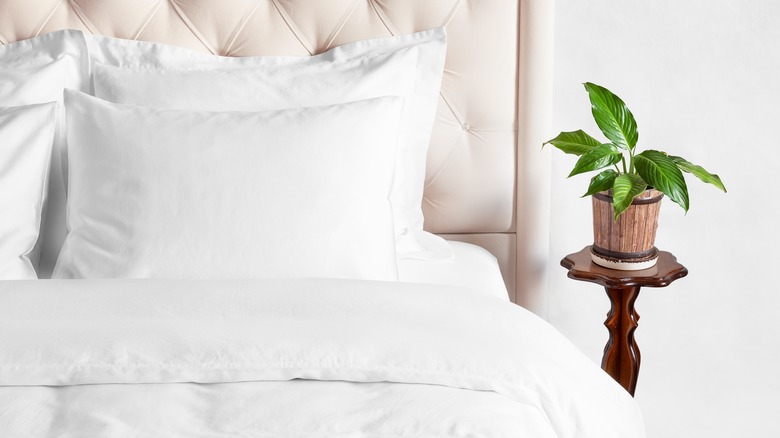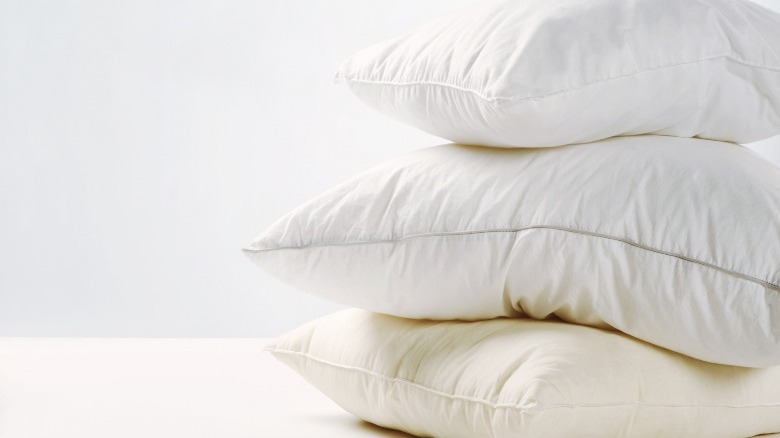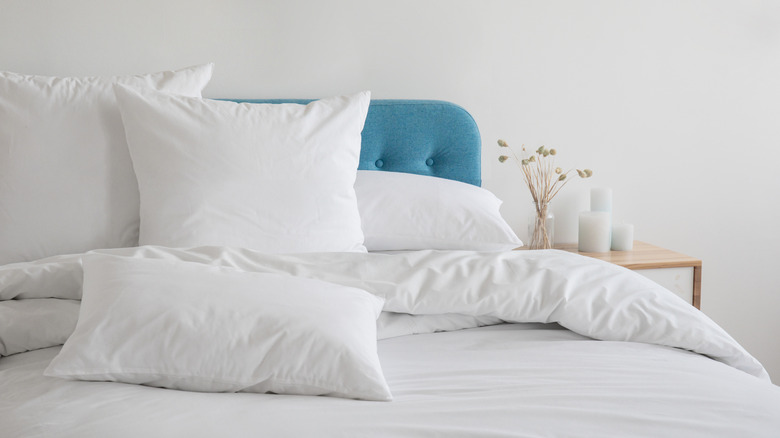Why Your Pillows Are The Most Important Bedding To Wash Properly
Many of us likely have a set schedule for washing our bed linens, but few (if any) are likely to pay attention to washing our pillows on a regular basis — which, as it turns out, can get pretty gross. With the amount of time we spend sleeping — eight hours a day if we're good about it — Healthline points out that laying our heads on our pillows for that amount of time can turn them into a thriving germ and dust mite ecosystems. "Because pillows are an item we use nightly, over time everything they absorb creates an ideal environment for dust mites and bacteria to thrive," Jessica Hann, senior director of partnerships at organic mattress company Avocado Green Mattress told The Telegraph. "Particularly for those who suffer from allergies, this can cause adverse health effects."
South Carolina-based allergist immunologist Neil Kao agrees. "Over time, hair, dead skin cells, sweat, and drool build up on the pillow," he explained to Consumer Reports, giving unwanted guests like dust mites things to eat, a place to hang around, and eventually space to multiply. WebMD takes it one step further, warning that they have also been known to harbor fungi, bacteria, and adenoviruses; the latter has been linked to a host of health problems including coughing, sore throat, diarrhea, and pinkeye, as noted by WebMD.
Not all pillows are the same
Not all pillows attract dust and germs in the same way. Per Healthline, if yours is made with latex foam, memory foam, gel, or hypoallergenic material, it is less likely to accumulate dirt and dust mites. Additionally, studies show that goose down pillows are likely to offer up a good gathering place for dust mites when compared to those made with wool.
Regardless, pillows still need to be washed regularly, and the frequency with which you do this will depend on factors that include whether you sleep with your pets, or if you eat or drink in bed. Cleaning expert Melissa Homer, who is chief cleaning officer at MaidPro tells Consumer Reports that, "If your pillow can withstand being laundered, you should wash it at least twice a year, or quarterly if you sweat a lot, eat in bed, or have pets sleep in your bed with you."
HuffPost agrees, saying that the outer cover needs to be washed at least once every three weeks. The pillow itself should be laundered every three months.
How to wash your pillows the right way
Knowing your pillow needs to get washed regularly is just half the battle — there's getting it done properly, too. If yours isn't fussy and will take to any form of cleaning, Family Handyman spoke to Molly Maid executive vice president Michael Silva-Nash, who recommends throwing them in the washing machine. Load just two at a time, use a mild detergent, and wash in warm water on gentle. The Telegraph further says you may want to give pillows an extra turn in the spinner just because they are absorbent.
Do note that memory foam and gel pillows don't do well in the washing machine, but they can be spot cleaned with soap. Down and feather options need to be washed in cold water, per Healthline. Once that's done, you can load them in the dryer with two tennis balls to keep your pillows plump and happy.
How else should you care for your pillows to ensure they are clean and fresh? Use protectors, and air yours out once a month by hanging them on a laundry line outside on a nice sunny day. Give them a good fluff and you're good to go.


